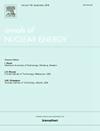基于深度学习增强多目标遗传算法的HPR1000堆芯平衡循环重装模式优化方法研究
IF 1.9
3区 工程技术
Q1 NUCLEAR SCIENCE & TECHNOLOGY
引用次数: 0
摘要
提出了一种利用深度学习和多目标遗传算法(MOGA)设计和优化压水堆平衡循环加载模式的新方法。该深度学习模型高效、准确地预测了反应堆物理参数,特别是循环末燃料组件燃耗,并形成了适应度函数。适应度函数取循环开始时适形燃料组件的燃烧量(BOC)与EOC之间的绝对差值,从而缩小了潜在的平衡再加载模式。将深度学习模型与MOGA相结合,同时优化多个目标,实现平衡周期的设计与优化。将该方法应用于HPR1000反应堆,第一个平衡周期长度为473.1有效满功率日(efpd), 10个周期平均为471.1 efpd,满足反应堆安全设计准则的所有参数。本文章由计算机程序翻译,如有差异,请以英文原文为准。
Method research on equilibrium cycle reloading pattern optimization for the HPR1000 reactor core using deep learning-enhanced multi-objective genetic algorithm
A novel methodology for designing and optimizing a PWR’s equilibrium cycle reloading pattern using deep learning and a multi-objective genetic algorithm (MOGA) has been developed. The deep-learning model efficiently and accurately predicted reactor physics parameters, particularly fuel assembly burnups at the end of the cycle (EOC), and formed a fitness function. The fitness function takes the absolute difference between the conformable fuel assemblies’ burnups at the beginning of the cycle (BOC) and the EOC, which narrows down the potential equilibrium reloading patterns. The deep-learning model was coupled with MOGA, which simultaneously optimized multiple objectives for the design and optimization of an equilibrium cycle. Applied to the HPR1000 reactor, the method achieved the first equilibrium cycle length of 473.1 Effective Full Power Days (EFPDs) and an average of 471.1 EFPDs over ten cycles, meeting all the parameters of reactor safety design criteria.
求助全文
通过发布文献求助,成功后即可免费获取论文全文。
去求助
来源期刊

Annals of Nuclear Energy
工程技术-核科学技术
CiteScore
4.30
自引率
21.10%
发文量
632
审稿时长
7.3 months
期刊介绍:
Annals of Nuclear Energy provides an international medium for the communication of original research, ideas and developments in all areas of the field of nuclear energy science and technology. Its scope embraces nuclear fuel reserves, fuel cycles and cost, materials, processing, system and component technology (fission only), design and optimization, direct conversion of nuclear energy sources, environmental control, reactor physics, heat transfer and fluid dynamics, structural analysis, fuel management, future developments, nuclear fuel and safety, nuclear aerosol, neutron physics, computer technology (both software and hardware), risk assessment, radioactive waste disposal and reactor thermal hydraulics. Papers submitted to Annals need to demonstrate a clear link to nuclear power generation/nuclear engineering. Papers which deal with pure nuclear physics, pure health physics, imaging, or attenuation and shielding properties of concretes and various geological materials are not within the scope of the journal. Also, papers that deal with policy or economics are not within the scope of the journal.
 求助内容:
求助内容: 应助结果提醒方式:
应助结果提醒方式:


